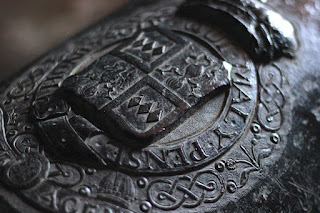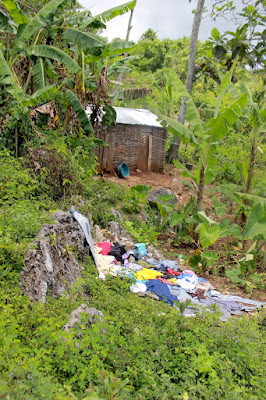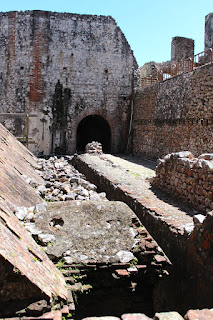It was Sofie's first ever trip to the Citadel, and the girls had so much fun. Best of all, it was a wonderful day spent with dear friends...Jane, Robert and Isaac are such encouraging and godly friends. Having them in our lives more intimately for a few days is SUCH A GIFT!
The massive stone structure was built by up to 20,000 workers between 1805 and 1820 as part of a system of fortifications designed to keep the newly independent nation of Haiti safe from French incursions. The Citadel was built several miles inland, and atop the 3,000 ft (910 m) Bonnet a L’Eveque mountain, to deter attacks and to provide a lookout into the nearby valleys.
Cap-Haïtien and the adjoining Atlantic Ocean are visible from the roof of the fortress. Anecdotally, it is possible to sight the eastern coast of Cuba, some 90 miles (140 km) to the west, on clear days.
The Haitians outfitted the fortress with 365 cannons of varying size. These were obtained from various nations, and still bear the crests of 18th Century monarchs. Enormous stockpiles of cannonballs still sit in pyramidal stacks at the base of the fortress walls. Since its construction, the fortress has withstood numerous earthquakes, though a French attack never came and it was eventually abandoned.
The colossal physical dimensions of the fortress have made it a Haitian national symbol, featured on currency, stamps, and tourist ministry posters. The fortress walls rise 130 feet (40 m) from the mountaintop and the entire complex, including cannonball stocks but excluding the surrounding grounds, covers an area of 108,000 square feet (10,000 m2). Workers laid the large foundation stones of the fortress directly into the stone of the mountaintop, using a mortar mixture that included quicklime, molasses, and the blood of local cows and goats—and cows hooves that they cooked to a glue and added to the mix to give the mortar added strength and bonding power.
Large cisterns and storehouses in the fortress's interior were designed to store enough food and water for 5,000 defenders for up to one year. The fortress included palace quarters for the king and his family, in the event that they needed to take refuge within its walls. Other facilities included dungeons, bathing quarters, and bakery ovens. Also visible is the tomb of Christophe's brother-in-law, killed when the gunpowder room he was in exploded.
The Citadel's appearance from the trail leading up to its base has been likened to the prow of a great stone ship, jutting out from the mountainside. The structure is angular and assumes different geometric forms based on the viewer's orientation. Some of the angles on the Citadelle were intentionally put there by Christophe to deviate cannonballs if attacked and the Epaulette is a great example of using angles to deviate and deflect shots.
Our good friend Maurice grew up and lives in one of the homes along the Citadel trail, and catching up with him today was a gift! This past Tuesday he brought 10 different churches near and around Milot together for Jodenel to come and train with our Growth Ministries Discipleship materials and they all had an awesome day together. He is currently working hard to finish this above home for he and his finance (in the pink)...their wedding is in 2 weeks!
Always learning something new, today he was showing us a new fruit....the strings in it are poisonous, but when you cook the fruit he and the neighbors say it's delicious!
Tomorrow Jane and Isaac are going to homeschool, Matt, Robert and I are going to catch up at the office, and then we're all off to visit Mme Prudence, just returned to Haiti after the sad death of her husband.
Yay for friends, for beautiful people who love the Lord and share Him with you freely.


















































No comments:
Post a Comment